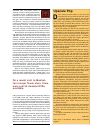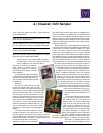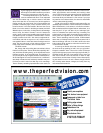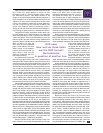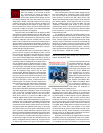
Verdi: Attila (La Scala production), Image Entertain-
ment ID4360PUDVD.
Cilea: Adriana Lecouvreur (La Scala production), Image
Entertainment ID4362PUDVD.
Dvorák: Symphony No. 9, “From the New World” (Her-
bert von Karajan conducting), Sony Classical SVD 48421.
Vivaldi: The Four Seasons (Herbert von Karajan con-
ducting), Sony Classical SVD 46380.
New Year’s Concert, Vienna 1987 (Herbert von Karajan
conducting), Sony Classical SVD 45985.
erewith the rest of my classical DVD smorgasbord –
the appetizers, if you like, the desserts, the smaller
items (compared to the oversized Beijing
Turandot), all involving big classical-
music names, but chosen with no
attempt to be complete or comprehen-
sive. Consider them a sampler, a taste of
what’s available.
I’ll examine them under two headings
– as DVDs (looking at the DVD-ness of the
products, how well they use the DVD for-
mat, its resources, and its interface) and as
performances.
DVD-ness:
How well do these items use the DVD
format? The overall answer: Not very well.
Neither the Karajan nor the Scala series offers
a 16.9 image, for instance. (Both series include more
releases, the Scala many more.) The Scala DVDs
offer nothing but an opera performance; no com-
mentary, no plot synopsis (well, there’s one on the
box the disc comes in), nothing. There’s no libretto,
either, as there isn’t for the BMG Turandot, so you
can’t take your time to prep yourself, and then
watch the opera without subtitles. But wait – you
can’t turn the subtitles off, so that isn’t an option
anyway. Nor can you get them in any language but
English.
The chapter menu shows itself with a touch
of operatic cuteness; a red curtain parts, to the
sound of applause. How quickly will you get sick of that? At
least the selection bar, which shows you which scene you’ll
chose by hitting “select,” is elegant, an image of one line of a
musical manuscript. But now we come to
something really weird. For Verdi’s Attila
(yes, Verdi really wrote an opera about the rampaging Hun;
more on that below), the chapters don’t correspond with the
start of scenes. Just imagine a CD that worked this way. The
soprano (a warrior woman Attila admires) finishes her aria,
and goes offstage. Now the baritone arrives; he’s an ambas-
sador from imperial Rome, and he’s here for formal colloqui-
es with Attila, the bass.
But the new CD track wouldn’t begin with his entrance. No,
it starts only when the baritone and bass begin the melodic part
of their duet! If you want to hear their recitative, or in other
words if you want to start the scene from the baritone’s
entrance, its natural beginning, you’re out of luck. Nobody
would accept that on CD, but that’s how this DVD is planned.
The chapters take you from one musical highlight to another;
they don’t let you page through the opera scene by scene. If you
want the baritone’s entrance, you have to find the soprano’s
aria and fast forward, or find the Attila/ambassador duet, and
hit rewind. This frustrated me to no end; there are parts of
the opera that are quite literally inaccessible, unless you
scan forward or back from one of the official landmarks.
Adriana Lecouvreur works better, but has yet anoth-
er oddity. Each act begins with the white-haired con-
d u c t o r, Gianandrea Gavazenni, whom the audience
adores, entering the orchestra pit. If you don’t want to
see that, you’re in luck, because the chapter on the
DVD begins a moment later, when the music starts.
But we hear the music too abruptly; the chapter all
but coincides with the first note, which, no matter
how many times I tried to get used to it, came as an
uneasy shock. I make my own CDs at home, and I’ve
learned to leave a breath between the start of each
new track and the beginning of the music.
For exactly the same reasons, I wished that
I could start each act with Gavazenni, but I
couldn’t.
The Karajan discs are a little more elab-
orate. They offer program notes and bios.
But what the point is, I’m not quite sure,
because these are simple, undecorated
texts, which to me at least would be much
easier to read in a booklet than on my TV
screen. (The program note for The Four Sea -
sons, I might add, amounts to little more than
just another biography of Karajan, with
almost nothing about the work or the soloist.
But that’s a separate complaint.) Each time
you want to read them, by the way, you have to choose your
language, English, Deutsch, or Français. This gets annoying,
and while it’s a separate software issue
(there isn’t any DVD standard for choos-
A (Classical) DVD Sampler
. . . . . . . . .
G R E G S A N D O W
ˇ






